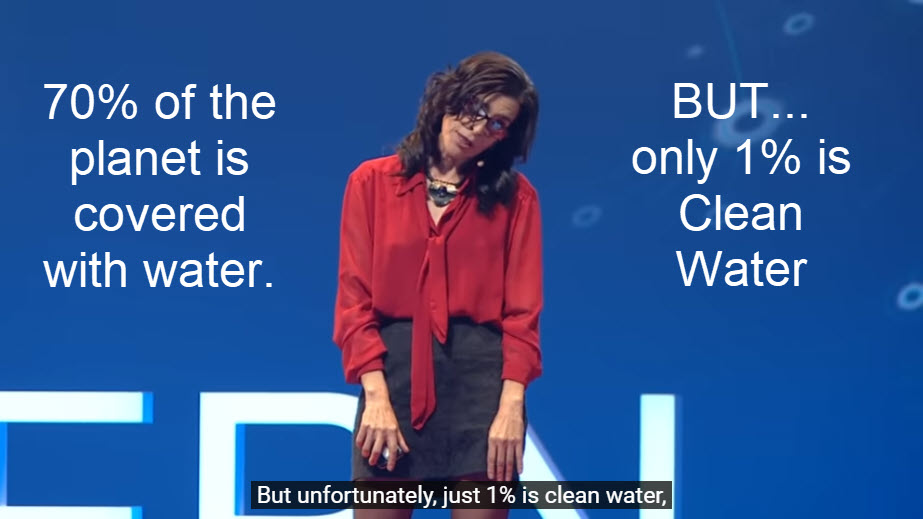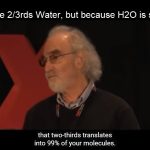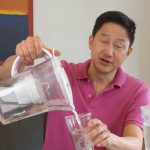Just because water covers 70% of the earth’s surface and composes the majority of our bodies doesn’t mean we know everything about it
Marcia Barbosa, TEDxCERN
This talk was given at a local TEDx event, produced independently of the TED Conferences. Just because water covers 70% of the earth’s surface and composes the majority of our bodies doesn’t mean we know everything about it. Marcia Barbosa talks about the many anomalies of water and how exploiting them with nano-tubes could help address the problem of freshwater shortages.
Marcia Barbosa has a PhD in physics from Brazil’s Universidade Federal do Rio Grande do Sul, where she is now the director of its Physics Institute. She studies the complex structure of the water molecule, and has developed a series of models of its properties which may contribute to our understanding of how earthquakes occur, how proteins fold, and could play an important role in generating cleaner energy and treating diseases. She is actively involved in promoting Women in Physics and was named the 2013 L’Oreal-UNESCO for Women in Science Awards Laureate for Latin America.
Video Transcript:
0:00Transcriber: Leonardo Silva Reviewer: Emma Gon
0:19I do love water.
0:23I love to swim, to surf,
0:27and even to drink water.
0:29And do you know why I love water?
0:32Because I am water!
0:35Two thirds of our body
0:38is made of water.
0:40And because of that,
0:42for the last fifteen years,
0:45kind of since high school,
0:48I have been studying water.
0:51And I have a secret to tell you:
0:55water is weird,
0:58pretty weird.
1:01OK, it’s weird, but it’s also fundamental to our lives,
1:06and fortunately,
1:0870% of the planet is covered with water.
1:14But unfortunately, just 1% is clean water,
1:201% is water that we might be able to drink.
1:25And that’s too little.
1:28Today, one in six people
1:32has lack of fresh water.
1:35And in 2050,
1:37it will be one in two people
1:42with lack of fresh water.
1:44Either you or me
1:47will have lack of fresh water.
1:49So, the world needs fresh water.
1:54Please, don’t panic,
1:56because today I’m going to tell you
1:59how we can use the weirdness of water
2:04to help us get more fresh water.
2:08So, you see, water is very important.
2:11But when I tell people I work with water,
2:14they usually say to me, “Well, such a simple molecule.
2:19We know everything about water.”
2:22Even my mom tells me this.
2:24But that’s not true.
2:26Water is not simple,
2:29and you have many things in water
2:32that we still need to understand.
2:35OK. You’re not convinced.
2:38Let’s compare water with another material:
2:42with silicon.
2:44Silicon is also abundant on the planet.
2:4828% of the crust of the Earth is composed of silicon.
2:54And silicon also has a number of unique properties.
2:59And the fact that silicon has unique properties
3:03and that we have learned how to use these unique properties of silicion
3:08allows us today to have cell phones,
3:12computers, flat screens
3:14and all these instruments that govern our lives today.
3:19And, you know what?
3:21Silicon has just half a dozen anomalies.
3:26Water? Water has seventy.
3:29Yes, 70 anomalies.
3:34So, it’s our duty to find ways to use
3:38these anomalous behaviors of water
3:41to have more clean water.
3:44So, how are we going to do that?
3:47Before answering this question,
3:50let me introduce you to two of the seventy anomalies of water.
3:56The first anomaly is the density anomaly.
4:01Most liquids contract under cooling.
4:05Water does the contrary.
4:08If you cool water, it expands.
4:11And that’s why ice, that you see on the screen,
4:16floats into liquid water,
4:18because ice occupies more volume, it is less dense,
4:22and it floats on the liquid surface.
4:25But much more interesting than ice floating into liquid water
4:30is the fact that zero-temperature water
4:34floats in four-temperature water.
4:37See the beauty?
4:39When you have winter in the northern hemisphere,
4:42you have ice, followed by zero-temperature water,
4:47and far, at the bottom of the river or lake,
4:52you have the warm four-centigrade water,
4:55with fish and plants surviving.
4:59If water was as common as other materials,
5:03in the first winter, in the glacial time,
5:06it would freeze from the bottom to the top,
5:09and all life would be killed.
5:12It’s not that cool — literally cool.
5:16So, now I come with the second anomaly.
5:20The second anomaly is the diffusion anomaly
5:23and it’s related to mobility.
5:26Water, when it’s denser, when it’s more compact,
5:31its molecules move faster.
5:34″OK, OK. Marcia is saying something wrong with that.
5:37I know that when I have more cars into traffic,
5:41the cars move slower.
5:42When I have more people in the shopping center,
5:45people move slower.”
5:47Water, when you have more water molecules,
5:52they move faster.
5:55Is not that bizarre?
5:58So, come one, what’s the mechanism for that?
6:02For that, I’m going to give you just a little class of physics.
6:06So, water is composed of one oxygen, the big guy,
6:09and two hydrogens.
6:11And inside the water molecule,
6:14the interaction is the covalent interaction.
6:17But between molecules you have a second interaction,
6:20the hydrogen-bond interaction.
6:23So, what’s the difference between the two of them?
6:25Covalent is very close,
6:28is very strong and is very tight.
6:31Hydrogen bond is further apart
6:34and is twenty times weaker. OK?
6:38So, covalent bond is like marriage,
6:42or is like [what] marriage was supposed to be.
6:45You know, the particles are moving together
6:49and they’re very tight.
6:51Hydrogen bond is more like flirting.
6:54You are more distant, you flirt here, you flirt there,
6:59you flirt everywhere.
7:01OK. Now I got it. I got it.
7:03When I decrease the temperature and I have ice,
7:07I have all the particles together,
7:09and all the hydrogen bonds made.
7:11So, I’m further apart.
7:14like frozen, I don’t move,
7:15but I have the hydrogen bonds.
7:17I heat a little bit the system, I break the bonds
7:20and particles can actually approach,
7:23and that’s why ice floats into water.
7:27But how does this increase mobility? Easy.
7:32It’s easier to flirt in a crowded party
7:37than to flirt in an empty party.
7:39So, that’s why molecules actually move around
7:43when they have more particles,
7:45making bonds, disrupting bonds,
7:48making bonds, disrupting bonds.
7:50Isn’t that cool? (Laughter)
7:53But, you know, not always
7:56hydrogen bonds are a good thing.
7:59This deep and great love water has for making bonds
8:05might make water end up in bad company.
8:07Water might make bonds with something that is poisonous to us,
8:12or something that makes water undrinkable, like salt.
8:17So, the bonds are not always a good thing
8:21and, actually, the industry uses this property of water making bonds
8:27to throw away the waste
8:30or to produce things.
8:32More industry, less clean water;
8:34more people, more need for clean water.
8:38So, now you can see why in 2050
8:41we are having you without clean water and me with clean water,
8:46you know, because we need new scientific methods
8:51in order to get more clean water.
8:52And that is where the anomalies of water come about.
8:59Years ago,
9:04we found that the very same mechanism
9:08that makes water move faster, to diffuse faster
9:13also makes water flow faster
9:18when confined in nanotubes.
9:21Let me explain what I mean by faster.
9:25In nanotubes, water flows 900 times faster
9:31than it would flow if the laws of physics
9:35that govern the sinks in our houses
9:37governed the nanotubes.
9:40So, water loves to be in these nanotubes.
9:43It enters and just ballistically flows.
9:47But salt doesn’t. Salt hates nanotubes.
9:51It has to undress the hydration shell of water
9:55to get inside the tubes.
9:56So, it doesn’t like nanotubes.
9:59So now, if you combine the love of water for nanotubes
10:03and the hate of salt,
10:05you have thousands of nanotubes put together
10:09as the perfect filter for desalinating water,
10:14water that we actually have in abundance on the planet.
10:20This is a possibility, a clear possibility for the future,
10:25when nanotubes become an industrial commodity.
10:29Great!
10:31However, and there’s always a “however”,
10:34I don’t live close to the sea.
10:37So, how can I get more fresh water,
10:42if I don’t live close to the sea?
10:44So, a few months ago,
10:47when I couldn’t sleep and I was surfing the internet,
10:50seeing, you know, weird animals, etc.,
10:54I came across this beetle
10:56from the desert of Africa.
10:58This animal is capable of capturing the vapor air,
11:04transform it into liquid water and drink it.
11:08Come on, how does this animal does that?
11:11On the back of the animal,
11:12there is an upper surface
11:15in which there are molecules that love water.
11:18And they love it so badly
11:20that they transform vapor into liquid —
11:23which actually requires energy.
11:26And then, there is a second layer that hates water.
11:30So, when the particles of liquid water come to the second layer,
11:34they just slide, as when water’s spilled on your sofa,
11:39which you covered with a polymer surface to avoid it getting wet.
11:45And then, the animal is so smart, this beetle,
11:48that he just leans to the front
11:51and water just comes directly to its mouth.
11:54Isn’t that perfect? Nature is perfect!
11:57So now, our group is developing
12:00a combination of those two mechanisms.
12:03We have water in nanotubes, flowing fast.
12:07The top of the nanotube loves water
12:11and the bottom of the nanotube hates water
12:15and we’re going to use that to transform vapor into liquid
12:19and into storage.
12:22So, stay tuned.
12:23And, years from now,
12:25water in nanotubes will solve the problem
12:29of lack of fresh water on the planet.
12:32Thank you very much.
12:33(Cheers) (Applause)














